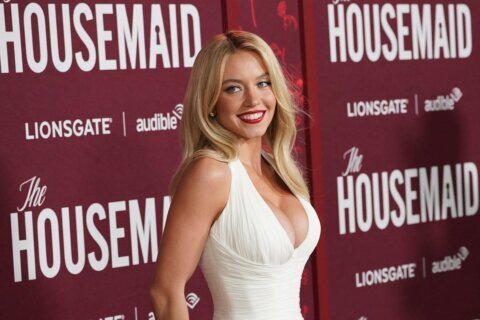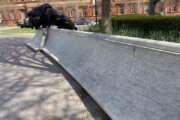WASHINGTON — After the silent pioneers of Charlie Chaplin, Buster Keaton and Harold Lloyd, Laurel & Hardy delivered a new era of slapstick talkies to rival Abbott & Costello, Hope & Crosby, The Marx Brothers and The Three Stooges as the top comedy teams in the world.
The twilight of their lives is explored in the delightful new biopic “Stan & Ollie,” which opens in D.C. movie theaters this weekend after a Dec. 28 limited release to qualify for award season.
Opening in 1937, Stan Laurel (Steve Coogan) and Oliver Hardy (John C. Reilly) strut confidently throughout the MGM backlot as the top comedy pair in Hollywood. We then jump ahead 16 years to 1953, as the duo barely hangs on by launching one final European vaudeville tour in an attempt to use their once-bankable names to raise enough money for one final picture.
In a movie like this, casting is everything. Thankfully, they nailed it here with the two leads.
Reilly looks exactly like Hardy, disappearing into the role with facial prothestics and a spot-on delivery of the signature line, “Here’s another nice mess you’ve gotten me into.” Not only did he earn a Golden Globe nomination for Best Actor: Comedy/Musical, it’s arguably the best turn of Reilly’s career, including art gems from “Boogie Nights” (1997) to “Chicago” (2002) and lowbrow comedies from “Walk Hard: The Dewey Cox Story” (2007) to “Step Brothers” (2008).
Meanwhile, Coogan masters Laurel’s mannerisms, raising his eyebrows with a goofy grin for on-stage gags like rolling a hardboiled egg and off-stage tricks like blowing his finger to make his hat rise. Like Reilly, he looks remarkably like his real-life counterpart, earning a much deserved Best Actor nomination at the British Academy of Film and Television Arts (BAFTAs).
Fittingly, the screenplay comes from Coogan’s “Philomena” (2013) screenwriter Jeff Pope, who cleverly inserts references to Laurel & Hardy classics. At one point, a Hollywood crew member sarcastically snickers, “A comedy-western? Whose bright idea was that?” in a clear reference to “Way Out West” (1937). At another point, their suitcase accidentally slides down a staircase, referencing the runaway piano in their Oscar-winning short “The Music Box” (1932). Movie buffs will also enjoy passing references to Hal Roach, Carole Lombard and Myrna Loy.
All the while, director Jon S. Baird (“Filth”) uses mirrors to symbolize two legends reflecting back on their careers. This motif begins with the opening shot where two bowler hats hang on a coat rack. As the camera pulls back to a two-shot of the duo on stools on both sides of the frame, dual mirrors capture the other’s face on either side, suggesting their images are tied.
Baird also delivers some “movie within a movie” magic by cutting to black-and-white recreated footage. His best moment comes by pushing in on a camera lens then pulling out of a movie screen to see Laurel & Hardy playing in front of a laughing audience. He ends by showing their shadows dancing on stage and their silhouettes staring out at the auditorium lights.
Beyond the filmmaking techniques, the real fun is simply watching Coogan and Reilly recreate all of the timeless gags: the duo going in and out of a house without seeing each other, Laurel accidentally hurting Hardy in a hospital bed, and Hardy hitting Laurel with mallet so that he can hit the high-note falsetto of “Blue Ridge Mountains of Virginia.” Afterward, a fan says, “It’s nice to see you two still going,” to which Hardy quips, “Yeah, rigor mortis hasn’t set in yet.”
This of course foreshadows Hardy’s health issues, one of several necessary conflicts, including retirement promises to their wives (Shirley Henderson as Lucille Hardy and Nina Arianda as Ida Kitaeva Laurel) and old career wounds of Hardy starring in a movie without Laurel, who had been fired from the studio. “You loved Laurel & Hardy, but you never loved me,” he says.
In the end, these conflicts melt away and are replaced by genuine affection on display each time Laurel calls Hardy “babe.” The end credits epilogue reminds us that Laurel never acted again after Hardy’s death, writing new sketches for the posthumous duo in his final years.
Their lovable bromance has inspired generations, including a Laurel & Hardy poster on Joey and Chandler’s wall in TV’s “Friends.” Their pop culture legacy lives on each time comedians take the stage, including Reilly’s number with Will Ferrell and Jack Black at the 2007 Oscars:
“A comedian at the Oscars, the saddest man of all,” Ferrell sings. “Your movies may make millions, but your name they’ll never call.”
“What did you think?!?” Jack Black retorts. “That you could change their wicked game? Did you think that when you made ‘Anchorman’ they wouldn’t call it lame?”
Just then, Reilly rises from the audience.
“This madness must stop,” Reilly sings. “There is no need to fear. You can have your cake and eat it, too. Just look at my career! I didn’t cry the blues, I didn’t pick silly fights, I chose to be in both ‘Boogie’ and ‘Talladega Nights!'”
As for “Stan & Ollie,” it’s another fine mess he’s gotten us into.








